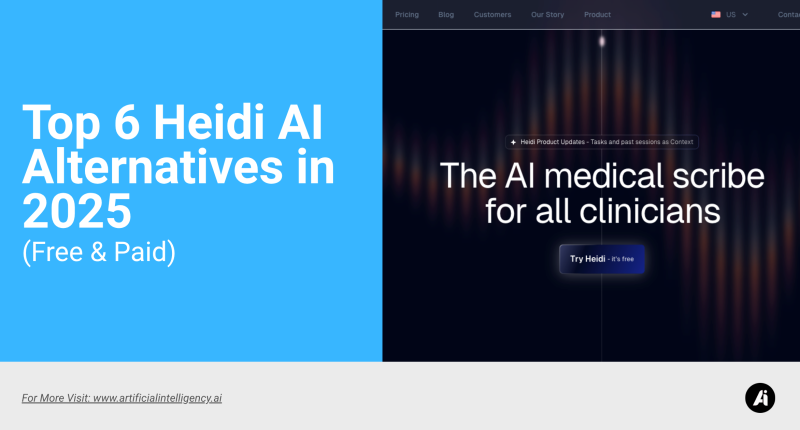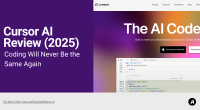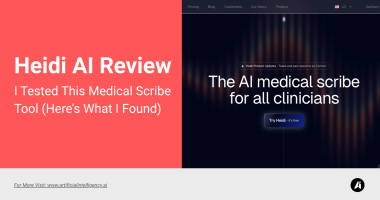I don’t know about you, but I’m done spending hours trying to remember who said what during a 10-minute consultation.
These days, AI medical scribes are saving lives—not just by documenting faster, but by giving clinicians their time (and sanity) back. And for many people, Heidi has been that lifesaver.
It’s smart, structured, and made specifically for clinical conversations. It listens, learns, and leaves you with fully formatted SOAP notes that make sense.
But let’s be real. Just because something’s good… doesn’t mean it’s perfect for everyone.
Maybe Heidi doesn’t quite fit your practice size. Maybe the pricing’s not what you expected.
Maybe you need something more specialized.
Or maybe you’re just curious about what else is out there (I was). So I went down the rabbit hole of alternatives.
G2. Toolify. Reddit threads. Product pages. You name it. And now, I’m bringing you the 5 most relevant, high-functioning Heidi AI alternatives for 2025.
Not just AI tools, but tools that work in real‑world clinics.
- Why Not Just Use Heidi?
- 1. Freed AI – For Real-Time, Real-World Transcription
- 2. Augmedix Go – Enterprise-Level Ambient Scribing
- 3. ScribeBerry – Friendly & Affordable AI for Students and Small Practices
- 4. DeepScribe – Smart Scribing with E/M & Coding Insights
- 5. Soapnote.ai – razor-fast, no-frills SOAP Notes
- 6. Twofold (NoteMD) – Mid-Range Accuracy & Customization
- Wrapping Up – What I Learned Looking Beyond Heidi
Why Not Just Use Heidi?
Fair question. And here’s my honest answer. Unlike what you’ll find in most Heidi AI reviews, this tool goes beyond transcription—it’s clinical-grade and context-aware.
Heidi AI is clinical-grade and context-aware. It doesn’t just transcribe your speech—it understands medical context.
Whether you’re diagnosing, prescribing, or explaining symptoms, Heidi knows where that info belongs in your notes. Plus, it organizes everything using the familiar SOAP format: Subjective, Objective, Assessment, and Plan.
But even great tech has limits.
- It’s not always budget-friendly for solo clinicians or small practices
- Still developing broader language support or integrations with niche EHRs
- You may want more control over formatting or edits
- Some users report the AI sometimes over-summarizes details
That’s why exploring other tools can be worth your time. Especially if you’re looking for something more customizable, lightweight, or affordable. Let’s check them out.
1. Freed AI – For Real-Time, Real-World Transcription
Freed AI feels like it was made by someone who’s actually been in the exam room.
This tool doesn’t just transcribe your speech—it creates clean, structured, ready-to-review medical notes while you go about your consults. The magic? You don’t have to prompt it.
Just press record, speak naturally, and Freed listens in the background, analyzing every relevant symptom, plan, or diagnosis as it happens. Unlike traditional dictation tools, it’s built to recognize medical context, not just words.
So instead of giving you a long, messy transcript, it produces refined notes in SOAP format—sorted and labeled. That’s a game changer for doctors juggling patient care and documentation.
Freed is also device-flexible. You can use it on a laptop, desktop, or even your phone, making it perfect for telehealth or in-clinic use.
It’s HIPAA and SOC2 compliant, which means you can use it in real clinical settings with confidence.
Key Features
- Real-time audio capture during patient consultations
- Smart SOAP note formatting: Subjective, Objective, Assessment, Plan
- Multi-specialty support (family medicine, derm, ortho, psych—you name it)
- Customization: Edit and tweak notes before export
- Works on desktop, mobile, or tablet
- HIPAA-compliant + SOC2 secure for real patient data
Use Case
If you’re a clinician looking for something that simply works without setup drama, Freed is a strong contender.
It’s ideal for solo practitioners, urgent care providers, or anyone doing a high volume of patient interactions who wants their evenings back.
It’s also excellent for mobile care providers or telehealth doctors who need a fast, portable solution without relying on big hospital systems or IT support.
Pros
- Easy to use—literally just press record
- Doesn’t interrupt or force you to change your consultation flow
- SOAP formatting saves time vs. raw transcripts
- Works across multiple specialties and device types
- Reduces burnout by cutting hours of admin every week
Cons
- No full EHR system inside—just scribing (though you can integrate)
- Advanced custom features like macros/templates are still evolving
- Accuracy may dip slightly in noisy environments
Pricing
Starts at $9o/month
Includes 200 minutes of clinical transcription. Additional minutes are billed separately based on usage.
There’s also a free trial if you want to test drive it before committing.
2. Augmedix Go – Enterprise-Level Ambient Scribing
What makes Augmedix Go different? It’s ambient, which means it works while you talk. You don’t have to click around or prompt the AI mid-sentence.
It listens in real-time during your consults, picks out relevant medical content, and turns that into structured clinical notes using your preferred format.
The platform is mobile-first—so whether you’re doing a virtual check-in from your phone or documenting bedside using a tablet, it’s designed to go wherever you go.
Unlike its older version that used human scribes behind the scenes, Go is powered entirely by AI, making it faster and more scalable.
And here’s the part that makes it perfect for large teams: it integrates directly into your EHR system. You don’t need to copy-paste anything.
You record, review, and notes land where they belong—inside Epic, Cerner, or whatever your clinic uses.
Key Features
- Ambient audio capture with natural language processing that generates draft notes
- Live note preview so you can edit as you go
- Works with major EHRs (Epic, Cerner, NextGen, etc.)
- Full compliance: HIPAA, HITRUST CSF, and enterprise security
- Analytics dashboard tracks clinician usage and outcomes
- Option to add “Assist” for coding, referrals, orders, and more
Use Case
Ideal for large practices, hospital groups, and health systems needing scalability, analytics, and full workflow integration without disrupting clinician routines.
Pros
- Scales across teams–great for group deployment
- Strong compliance and security features
- Enhances clinician productivity with ~14–16% hourly workflow improvement
- “Assist” offers full-spectrum documentation services
Cons
- Higher cost—starts at enterprise pricing
- Setup and onboarding may take weeks, not days
- No public per-user pricing; you’ll need to contact for a quote
Pricing
Starts at custom enterprise pricing, typically in the high hundreds to low thousands per clinician/month. Offers free trial access and flexible per-team contracts.
3. ScribeBerry – Friendly & Affordable AI for Students and Small Practices
Scribeberry doesn’t try to be everything—and that’s exactly why it works so well.
It’s simple, approachable, and built for people who are still figuring things out—whether you’re a medical student learning how to write proper SOAP notes, a resident trying to balance rotations with rest, or a new clinician handling patient flow without a support team.
At its core, Scribeberry is an AI-driven tool that takes your clinical thoughts—spoken or typed—and formats them into clean, readable SOAP notes.
And it does it without bombarding you with features you don’t need. It runs directly in your browser, doesn’t require any hardware setup, and feels like you’re working with a study buddy who actually knows medicine.
Key Features
- Real-time dictation and transcription with SOAP template output
- Drag-and-drop templates and smart autocomplete
- Learns from your style over time
- Browser-based with no install needed
- HIPAA-compliant ambient transcription
Use Case
Great for quick, reliable note-taking in educational settings or low-volume clinical environments. Perfect for med students, residents, locum tenens, or small private practices.
Pros
- Clean interface with virtually no learning curve
- Pro plan is budget-friendly at $99/month
- Free tier available for casual use
- Good template and auto-formatting features
Cons
- No advanced features like analytics, EHR integration, or reporting
- May not handle high-volume workflows
- Not ideal for large clinics or hospital systems
Pricing
- Free plan: Basic features
- Pro plan: $99/month or $999/year, unlimited usage
4. DeepScribe – Smart Scribing with E/M & Coding Insights
DeepScribe is one of those tools that quietly does the heavy lifting in the background, without asking you to change how you practice.
If you’re the kind of provider who likes to talk naturally, go with the flow, and not worry about “feeding” an AI script with perfect cues—DeepScribe might be your match.
It’s what I’d call a truly “ambient” medical scribe. You start the conversation with your patient—just as you always would—and DeepScribe listens in, silently capturing the entire encounter.
But here’s what makes it stand out: it doesn’t just record and transcribe. It understands what you’re saying in a clinical context. It knows what’s important, what’s routine, what’s noise, and what belongs in each part of your SOAP note.
Once you’re done with your consult, DeepScribe auto-generates a draft note with everything properly categorized: subjective complaints, objective findings, assessment, and plan.
And if you’ve got favorite phrases or phrasing styles, over time, it starts to mimic that too. That level of personalization feels like having a real assistant who actually knows your work habits.
Key Features
- Hands-free ambient note generation
- Full SOAP note output
- Built-in AI for E/M and HCC coding recommendations
- EHR integration with many popular platforms
- HIPAA-compliant workflow
Use Case
Tailored for clinicians aiming to maximize coding accuracy and billing while preserving natural consultation flow—especially across high-volume specialties.
Pros
- Streamlines both documentation and billing
- Enhances compliance and helps prevent under/overcoding
- Integrates well with major EHRs
- Detaches administrative load from clinicians
Cons
- Initial setup and learning curve (about three weeks)
- Pricing depends on organization size, specialty, and integration level—no public figure available
- May need device charging strategies for long sessions (battery drain reported)
Pricing
Starts around $8,000/year per organization (quote-based), roughly $666/month org-wide .
5. Soapnote.ai – razor-fast, no-frills SOAP Notes
Soapnote.ai is minimalistic genius: a clean, web-based SOAP note generator that transforms spoken or typed input into structured notes with zero setup.
No login, no EHR, no friction—just fast writing.The interface is as clean and minimal as it gets.
You just go to the site, type or speak what happened in your encounter, and within seconds, you’ve got a fully structured SOAP note. No sign-in required. No browser extensions. No tutorials. You’re in and out.
What’s surprising is just how smart it is. Even with very little input—like a few bullet points or a rough voice dictation—it understands how to lay out a clinical note.
It picks up on whether you’re talking about a patient complaint, a physical finding, or a plan of care, and it assigns the right section.
It may not be perfect for a 30-minute complex consultation, but for quick visits, follow-ups, or telehealth drop-ins? It’s brilliant.
It’s built for those moments when you need a quick note without fighting with software.
Key Features
- Instant note generation from audio or typed prompts
- Simple SOAP formatting, ready to download or copy
- Unlimited session support (with premium plans)
- No account or sign-in required for basic use
- HIPAA BAA available with professional plans
Use Case
Ideal as a backup or ad-hoc tool—when you’re off the grid, in a pinch, or just want instant charting without logins, demos, or training.
Pros
- Lightning-fast and intuitive
- Free for occasional use
- Professional plans remain very affordable
- Great for telehealth, remote clinics, or brainstorming
Cons
- No EHR integration
- BAA is optional and may require pro plan
- Not built for daily high-volume use
Pricing
- Free plan: Includes 5 free visits/month
- Professional: $60/month for up to 5 visits/day
- Unlimited: $99/month for truly unlimited usage
6. Twofold (NoteMD) – Mid-Range Accuracy & Customization
Twofold—also known as NoteMD—balances accuracy, customization, and cost. It’s not as flashy as the big enterprise tools, but it also doesn’t try to play it too simple.
It’s designed for clinicians who want an AI scribe that’s flexible, professional, and affordable—without sacrificing control.
The main thing that sets Twofold apart is how customizable it is. It doesn’t assume every clinician wants the same kind of SOAP note. Maybe your ortho notes need more detail in the “Objective” section.
Maybe you’re in psych and prefer longer narrative assessments. Twofold lets you shape the structure and templates of your notes to match how you practice.
While it doesn’t offer deep EHR integration (yet), it’s HIPAA-compliant and built on a secure cloud environment, so you can use it in live patient settings without worry.
And because the team behind it is focused on rapid development, features are constantly improving—without you needing to update or upgrade anything yourself.
Key Features
- Live SOAP note generation from ambient speech
- Extensive daily and specialty templates
- Customizable templates to match your workflow
- HIPAA-compliant cloud infrastructure
Use Case
Perfect for providers who want a mid-tier tool—more feature-rich than basic scribes, but without enterprise-level onboarding or pricing.
Pros
- Good accuracy with natural speech capture
- Template customization maximizes flexibility
- Clear pricing structure ($99/month)
- Cheaper than enterprise alternatives
Cons
- Not as widely proven as Heidi or DeepScribe
- EHR integration may require extra setup
- Lacks large-scale analytics and dashboard features
Pricing
Free. Pro plans starts at $49/month per provider .
Wrapping Up – What I Learned Looking Beyond Heidi
Heidi is a fantastic tool. No doubt about it. It’s fast, clinical, and smart where it needs to be. But when I started looking around—really comparing other options—I realized there’s no one-size-fits-all when it comes to AI scribing.
Some of us need lightweight tools that run in the browser without an IT department.
Some need full-on enterprise workflows with EHR syncing, coding, and staff-wide dashboards.
Some of us are still learning how to write SOAP notes properly.
And some of us just need to save time without losing our voice in the process.
What matters most is how a tool fits into your day—your consult style, your specialty, your speed, your comfort with tech.
Whether it’s something simple like Soapnote.ai or something full-scale like Augmedix Go, the best AI scribe isn’t always the flashiest—it’s the one that lets you do your job better, not differently.
So if Heidi works for you, stick with it. But if you’ve felt the itch to explore, I promise—there are other options worth your time.



